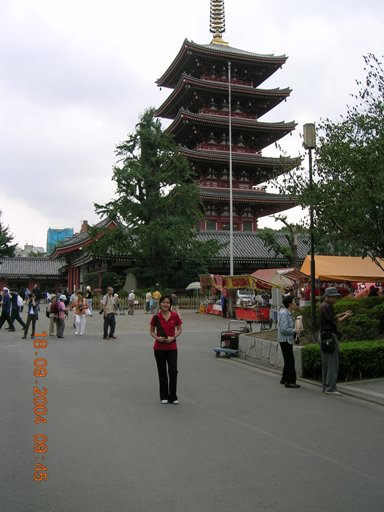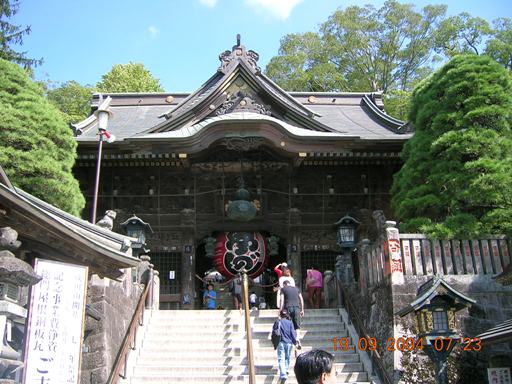I and P.Ou has been to Japan during September 14-19, 2004 with a travel agent. We went to Universal Studio, Nagoya Castle, Lake Hamana-ko, Mt. Fuji, Hakone National Park, Owakudani Valley, Asakusa, Meiji Shine and Harajuku, Narita-san Shinsho-ji Temple. We experienced riding bullet train, Shinkansen, and also spending a night in yokan and onsen which was enjoyable a true Japanese atmosphere, completed with tatami mats, yukata dresses, and hot baht tub. Food with tour was OK but it was better with our own choice. The following is the story of some places that we visited.
See photo of my Japan trip at http://picasaweb.google.com/arthivon/Japan2004#
Thursday, September 30, 2004
Universal Studio Japan
Nagoya Castle
 Nagoya Castle is almost in the center of Nagoya, and is famous for the golden dolphins that adorn the roof of its castle tower. The castle was built in 1612 by Tokugawa Ieyasu, the then-shogun of the Edo government. Until the revolution of 1867 it was the residence of the Owari Tokugawas, one of the three Tokugawa houses. Much of the castle was burnt down in 1945 during the World War II air raids, but the tower was rebuilt in 1959 as a reinforced concrete building with seven stories above ground and a basement. Since then, it has continued to be a beautiful symbol of Nagoya. Floors 1 to 5 inside the castle have been opened up as exhibition rooms.
Nagoya Castle is almost in the center of Nagoya, and is famous for the golden dolphins that adorn the roof of its castle tower. The castle was built in 1612 by Tokugawa Ieyasu, the then-shogun of the Edo government. Until the revolution of 1867 it was the residence of the Owari Tokugawas, one of the three Tokugawa houses. Much of the castle was burnt down in 1945 during the World War II air raids, but the tower was rebuilt in 1959 as a reinforced concrete building with seven stories above ground and a basement. Since then, it has continued to be a beautiful symbol of Nagoya. Floors 1 to 5 inside the castle have been opened up as exhibition rooms.Mt.Fuji
 Mt. Fuji is 3,776m high and is the highest mountain in Japan situated at the border of southeastern Yamanashi and Shizuoka. With its unrivaled magnificence and beautiful conic shape, Mt. Fuji has often been selected as the subject for paintings and literature. It is the world famous symbol of Japan.
Mt. Fuji is 3,776m high and is the highest mountain in Japan situated at the border of southeastern Yamanashi and Shizuoka. With its unrivaled magnificence and beautiful conic shape, Mt. Fuji has often been selected as the subject for paintings and literature. It is the world famous symbol of Japan.Mt. Fuji has long been the center for the mountain worship of ancient Japan. Today, it is a popular mountain to climb, and many people climb Mt. Fuji to watch the sunrise called Goraiko from the top. To access Mt. Fuji depends on weather condition, however the path to the 5th station is well maintained, and because of the time constrains, so we just went up to this point and enjoyed the magnificence of Mt. Fuji by just looking at the beautiful scenery without climbing all the way to the top.
Hakone National Park
Owakudani Valley
The crater, which was formed in the last vaporous eruption of the Hakone mountains when the highest mountain in Hakone, Mt.Kami erupted 3000 years ago, has spouted out hot vapor and sulfide to this day. Once known as Oojigoku("hell"), or grand hell, it was renamed "Oowakudani" before the Meiji emperor's visit in 1876 since it was not a good for the Emperor to visit a place called "hell". There were black eggs boiled from hot vapor and sulfide which it is believed that eat one egg can make your life 7 years longer.

Lake Ashi
Lake Ashi, 20km in circumference, is a slender lake formed in the Hakone caldera some 400 thousand years ago. The inverted reflection of Mt. Fuji viewed through the pine avenue in the southern shore is picturesque scenery. Lake Ashi abundant in pond smelt, trout, black bass and other kinds of fish, many people enjoy fishing there.

The crater, which was formed in the last vaporous eruption of the Hakone mountains when the highest mountain in Hakone, Mt.Kami erupted 3000 years ago, has spouted out hot vapor and sulfide to this day. Once known as Oojigoku("hell"), or grand hell, it was renamed "Oowakudani" before the Meiji emperor's visit in 1876 since it was not a good for the Emperor to visit a place called "hell". There were black eggs boiled from hot vapor and sulfide which it is believed that eat one egg can make your life 7 years longer.

Lake Ashi
Lake Ashi, 20km in circumference, is a slender lake formed in the Hakone caldera some 400 thousand years ago. The inverted reflection of Mt. Fuji viewed through the pine avenue in the southern shore is picturesque scenery. Lake Ashi abundant in pond smelt, trout, black bass and other kinds of fish, many people enjoy fishing there.

Senso-ji Temple and Asakusa
Located in Taito-ku along the west bank of the Sumida-gawa River, Asakusa once thrived as a temple town for Senso-ji Temple, and now it is a downtown that rivals with the Ginza, Shijuku, Ikebukuro and Shibuya. The history of Senso-ji Temple goes back far into the past. The legend has it that fishermen brothers discovered an image of Kan'non (the goddess of mercy) in the Sumida-gawa River around 1,370 years ago and they were inspired to enshrine it. Its symbol is a large red paper lantern that bears the word "Kaminari-mon", or a thunder gate. There is a constant flow of visitors and worshippers throughout the year. Numerous shops along Nakamise-dori Street that runs in the approach way to Senso-ji Temple carry a variety of small articles made of the Japanese paper and other traditional flavored goods such as folding fans. It is a lovely shopping street that attracts many foreign visitors.
 Many interesting shops along the road to the temple.
Many interesting shops along the road to the temple.
 Large censer outside the main building for followers to burn incense.
Large censer outside the main building for followers to burn incense.
 For the followers to wash their hands before paying their respects to the God.
For the followers to wash their hands before paying their respects to the God.
 Traditional Japanese pagoda
Traditional Japanese pagoda
 Many interesting shops along the road to the temple.
Many interesting shops along the road to the temple. Large censer outside the main building for followers to burn incense.
Large censer outside the main building for followers to burn incense. For the followers to wash their hands before paying their respects to the God.
For the followers to wash their hands before paying their respects to the God. Traditional Japanese pagoda
Traditional Japanese pagoda
Meiji Shrine
Narita-san Shinsho-ji Temple
Subscribe to:
Posts (Atom)





